Understand and master the design and simulation of tidal propeller turbines:
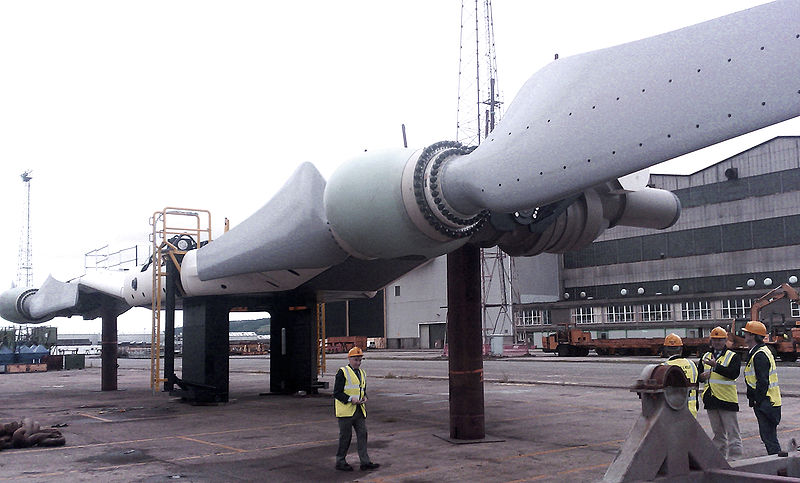
Hydropower result of capturing the kinetic energy of the fluid. Turbine propellers, tidal turbines, bulb or kaplan are used to capture low gradients with a high flow rate. When the altitude (pressure available) is important, will be used instead the Pelton turbines .See page mecaflux site turbines for the respective speeds and heights
We have seen that capture the energy of a fluid propeller is subjected to a performance limit expressed by the Betz limit (see theory froude energy capture), at 0.59. This means that our propeller will, in the best case, get that 0.59 times the energy of the fluid. However we speak of hydraulic turbines offering performance of around 0.8_0.9 !
- We must distinguish the propeller efficiency, from theperformance of the overall system: "guide vanes + turbine + draft tube" which form the whole system of hydraulic energy harvesting in penstocks.In all cases, the efficiency of the propeller may not exceed the Betz limit, but the fact that the fluid is in penstocks, gives us the opportunity to recover some of the energy that can not capture the propeller about 0.4 times the energy of the total fluid. We distinguish turbines in open water and turbines penstocks
Systems of energy capture with tidal turbines turbines in open water:We will study later in this page, only open water turbines, but the turbine types, kaplan, or bulbs, is deepened in the chapter on turbine propeller or Kaplan-type bulbs:

Chapter Summary hydroelectric turbines:
- kaplan hydraulic turbine energy capture 1/3 :Components Overview
- kaplan hydraulic turbine energy capture 2/3 :guide vanes + turbine
- kaplan hydraulic turbine energy capture 3/3 :design method
- Tutorial hydroelectric turbine design 1/3 :Site power and turbine design
- Tutorial hydroelectric turbine design 2/3 :Design :guide vanes or stator
- Tutorial hydroelectric turbine design 3/3 :Choice sections, design draft tube
The systems of energy capture with tidal turbines turbines in open water therefore can not exceed the Betz limit. But they are simpler than a hydroelectric plant. with dam and penstock.

For the propeller of tidal turbine (ducted or not), the Betz limit remains because the current is free around the propeller (with or without fairing), but if it is shrouded, losses at the tip of the blades will be strongly diminished.

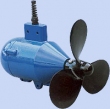
- Power(W)=0.5 X density(kg/m3) X(velocity)³ (m/sec) X disk area(m²)
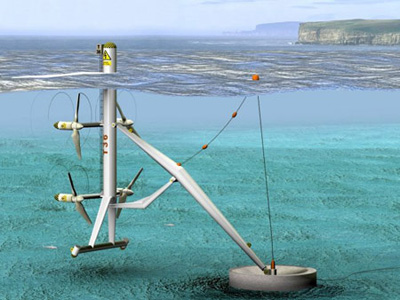
HélicielA tutorial blade design of tidal turbine is available to assess how to parameterize a tidal turbine project in héliciel. The power received by the tidal turbines is important, the profiles of the blades will have a thickness capable of withstanding the forces.is rather interested in the design of the turbine propeller of the tidal turbine part.. The propeller of the tidal turbine will have features that meet various constraints::
Representation of the drag and lift on a propeller turbine blade in Héliciel
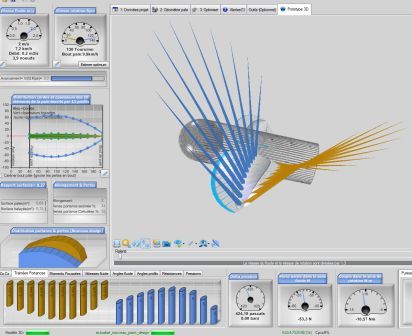
Liquid fluids such as water are subject to cavitation.The profiles of the blades or wings working in water must have a geometry, taking into account this phenomenon:The turbine and propeller cavitation is detailed here..
Results details as by elements of the pressure distribution on the blade in Héliciel
To reduce the concentration of lift and cavitation, can decide to increase the number of blade to spread and thus reduce the load on each blade. This within certain limits: the price of the blades, and the disturbance generated by the blades together..
The optimum rotation speed limit , is to be assessed taking into account these elements. The equation for the solution to this problem is complex and generates many solutions. Especially if you can get results in terms of efficiency, geometric definition of profiles whose performance determines the performance of our propeller remains to choose...Héliciel proposes to solve this complexity by an iteration procedure of speeds coupled with automatic data collection in a database storing the shape and performance of many profiles. see:(Find the Optimum speed with Héliciel)

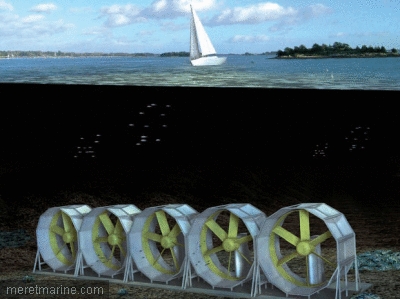
 Global site map
Global site map Mecaflux
Mecaflux Tutorials Mecaflux Pro3D
Tutorials Mecaflux Pro3D Tutorials Heliciel
Tutorials Heliciel Mecaflux Store
Mecaflux Store Compare software functions
Compare software functions Quotes, Orders, Payment Methods
Quotes, Orders, Payment Methods project technical studies
project technical studies